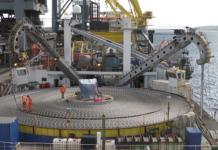Panduit discussed the latest developments in converged infrastructure solutions at DCD Zettastructure. Louise Frampton met with Sander Kaempfer and Michael Akinla to find out about the latest trends and strategies aimed at optimising facilities, from intelligent PDUs to software designed to reduce thermal risk
 Converged IT infrastructure is having an increasing contribution in relation to reduced energy consumption, as well as leading to better control of the IT compute environment, according to Panduit EMEA business development manager, integrated data centres, Sander Kaempfer. Emerging data centre trends, including virtualisation, can add complexity and increase implementation time. However, pre-configured infrastructures can help solve this problem.
Converged IT infrastructure is having an increasing contribution in relation to reduced energy consumption, as well as leading to better control of the IT compute environment, according to Panduit EMEA business development manager, integrated data centres, Sander Kaempfer. Emerging data centre trends, including virtualisation, can add complexity and increase implementation time. However, pre-configured infrastructures can help solve this problem.
Kaempfer explained: “Our strategy is to develop solutions for data centres that reduce deployment time. There is a need for more pre-configured, converged infrastructure solutions to help people to accommodate easier applications in a shorter time.”
Designed and built as an interoperable, end-to-end solution, Panduit ‘converged infrastructure solutions’ aim to facilitate faster implementation by streamlining the process of designing, specifying, installing and managing the increasingly complex physical infrastructure necessary to optimise the data centre. The company reports that pre-configured cabinet solutions can reduce time-to-production by up to 80%.
Among the solutions on show at this year’s DCD Zettastructure included intelligent PDUs (SmartZone) and real-time monitoring and automated environmental control (SynapSense).
Intelligent PDU
Kaempfer said that although 55% of customers currently opt for non-intelligent PDUs, the demand for intelligent solutions is growing. To meet this demand, the company’s ‘Generation 5’ PDU range will become available in both intelligent or non-intelligent versions by February 2018.
The G5iPDU is more than a power distribution unit and energy meter. These intelligent PDUs can monitor the data centre power and environment at the rack or cabinet level by continuously scanning for electrical circuit overloads and physical environmental conditions that place critical IT equipment at risk. The intelligent PDUs provide accurate energy measurement data to efficiently use power resources, make informed capacity planning decisions, improve uptime, measure PUE and drive green data centre initiatives to save energy and money.
“Customers are fully aware that they have to undertake capacity planning. If you want to do this properly, you have to understand your power draw. This can be done in an on-prem data centre as well as an off-prem data centre, with functionality for the tenant as well as the provider. Intelligent PDUs offer dual network access (DNA), which means the tenant can see exactly what the power draw is for capacity planning. At the same time, the provider can have an overview of the facility – both parties can obtain real-time monitoring information,” Kaempfer explains.
He claims that one of the features that makes the range “generations ahead” is the fact the PDUs can withstand 60oC under full loads. “Other competitors offer 60oC but not under full loads,” says Kaempfer. He adds that customers also have to measure the rack cooling index. For Class 4, the maximum allowable temperature is up to 55oC. The PDUs’ ability to withstand 60oC under full loads is an advantage, therefore. “We can also plug in temperature and humidity sensors to understand the rack cooling index,” he continues.
The controller is also hot swappable, so it can be replaced without having to power down the rack. According to Kaempfer, the mistake specifiers often make when choosing a PDU is not fully investigating the mean time before failure or ensuring the colour coding is highly visible. He points out that the PDU range has a long mean time before failure, backed by a three-year warranty.
“The deficits are in the details,” he warned. “Some PDU vendors do not use colour coding on the chassis. However, to simplify power feed identification and management, colour-coded PDUs are available to help reduce the risk of human error,” said Kaempfer.
A mechanical solution in the form of a cable tie facility is also incorporated to ensure that a critical power connection cannot be accidentally removed without physically cutting through the tie – this is a simple but important feature; human factors are among the biggest challenges with switched PDUs, according to Kaempfer.
Cooling optimisation
Converged infrastructure solutions can also improve efficiency by providing operators with crucial insights into their data centres. SynapSense Cooling Optimisation, part of the SmartZone Solutions portfolio, is a powerful DCIM thermal risk management and cooling energy savings solution for large enterprise, colocation and cloud computing service providers.
“We know that in traditional data centres the cooling system consumes 30-40% of the total energy – as SynapSense can reduce cooling capacity by up to 50%, users can also reduce their energy consumption,” said Kaempfer. “We have had case studies where customers have been able to save up to 15%-20% of the total power going into the facility.”
Kaempfer explained that Panduit can reduce thermal risks and maintain resiliency through a reliable and secure wireless mesh networking technology, airflow optimisation services and manual or automated cooling control. Overall, the SynapSense wireless monitoring and cooling optimisation solution provides visibility to enhance environmental consistency.
“In a lot of water cooled data centres with raised floors, operators do not balance the floor. There may be low pressure in one area and higher pressure elsewhere. We know that if you have low pressure, you will not have enough airflow through your precious IT equipment. This system measures differential pressure in the raised floor in the complete data hall. It also provides key temperature readings. The system not only reduces energy consumption but also helps operators meet SLAs,” Kaempfer commented.
Panduit Europe TSE manager EMEA Michael Akinla also revealed plans for 3D software to optimise the design of facilities. “We are working with our development partner, ICE, on the ability to offer a ‘walk through’ experience so that people can test out a design before it’s built. At present, we can provide a 3D movie ‘fly-through’ showing cabinets, containment, above and under floor, the fire suppression system and air handling system. However, next year, we expect to be providing certain elements in virtual reality to offer a more immersive experience for customers,” he explained.
“We are all about making the customer experience more user-friendly – but above all our solutions are designed to save the customer money, whether it is controlling the air, so that fan speeds can be reduced and ensuring that cabling isn’t blocking air flow; or enabling high density and ‘cramming’ as much connectivity as possible into the space, so there is more space for servers, etc.”
Akinla commented that the data centre market continues to flourish in the UK. “Brexit is always a concern – but, at this point in time, we are still seeing a lot of investment from multi-national companies. Growth in the UK is still strong,” he concluded.



